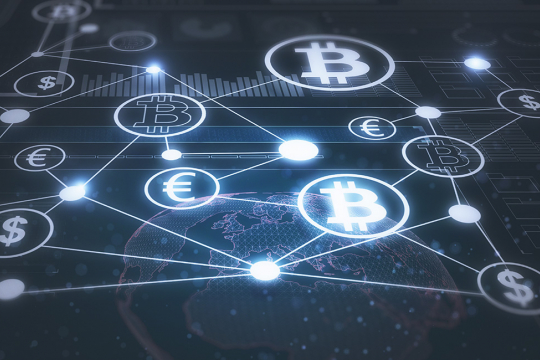
Digital finance integrates digital technology into financial services and transactions. Online banking, mobile wallets, digital investment platforms, and other financial tools help people manage their money. Traditional banks have gone digital to improve customer experience, reduce costs, and increase accessibility. Governments regulate these services, which rely on financial infrastructure. Millions of people use digital currencies to quickly transfer money and buy stocks with just a few taps on their smartphones. Despite improvements in efficiency and accessibility, digital finance relies heavily on banks, credit unions, and payment processors.
How Decentralized Finance Can Be an Alternative
Decentralized finance (DeFi) is an emerging blockchain-based movement that aims to eliminate financial intermediaries. DeFi applications use public blockchains such as Ethereum to allow users to conduct financial transactions without the need for centralized institutions, which is different from digital finance. Smart contracts on these platforms enable borrowing, lending, trading, and saving. DeFi gives customers complete autonomy over their assets while ensuring transparency and reducing the risks of centralized control. Unlike traditional digital currencies, DeFi is open-source, permissionless, and available to anyone with an internet connection and a compatible wallet.
Centralization in Digital Finance
Centralization is what sets digital finance apart from DeFi. Despite technological advances, digital finance is still centralized. Regulators and banks audit accounts, process transactions, and intervene. Consumer protection, fraud prevention, and government regulation are benefits of centralized control. Users of the digital financial system trust banks to manage their money. Problems are typically resolved through dispute resolution, insurance, or legal proceedings. Centralization still reassures many people because of the trust and accountability it provides.
Decentralization and User Autonomy in DeFi
DeFi puts users in control by eliminating intermediaries. Personal wallets interface directly with blockchain financial protocols, so participants always own their money. Users can make transactions without authorization and do not need other parties to authorize or support their financial decisions. A disadvantage is that DeFi has no central authority for disagreements or mistakes. Losing a private key, sending a payment to the wrong address, or using a flawed smart contract is usually irreparable. DeFi gives people autonomy but also requires them to take more responsibility and gain more system knowledge.
Security and Risk Management of Both Systems
Both DeFi and digital finance prioritize security, but their approaches differ. Traditional digital finance companies invest heavily in cybersecurity, fraud detection, and regulatory compliance. Consumer protection, deposit insurance, and anti-fraud measures are also in place. DeFi security relies on blockchain networks and smart contracts. While blockchain technology itself is secure and reliable, DeFi has suffered huge losses due to flaws in smart contract codes or hacker attacks. DeFi does not have a government-backed safety net, so risk management must be personalized. Users must be cautious, research relevant measures, and understand the implications before participating.
Accessibility and Inclusion of Both Financial Models
Digital finance has made banking and investing easier worldwide, especially in areas with strong internet connectivity and high smartphone penetration. Mobile banking and digital payment systems have brought many unbanked people into the financial system. These services often require identity verification and national regulations, which can exclude some users. DeFi is a more open, borderless option. Because DeFi is decentralized, anyone with internet access and a crypto wallet can participate. The permissionless nature of DeFi makes it a vehicle for global financial inclusion, but regulatory oversight and consumer safety remain challenges.
Innovation and Speed of Development
The speed of innovation is what sets digital finance apart from DeFi. Regulatory frameworks, business strategies, and technology shape digital currencies. Compliance restrictions can delay the launch of banking products by months or even years. DeFi has been able to develop rapidly because decentralized developers can implement new protocols, offer experimental financial products, and respond to user input in a timely manner. This open innovation model encourages creativity and challenges financial conventions. The speed of DeFi makes it volatile and unpredictable, which can deter risk-averse customers or those unfamiliar with blockchain technology.
Transparency and Control of the Financial System
DeFi excels in transparency. Blockchain transactions are public, verifiable, and immutable. Anyone can audit the DeFi protocol code, observe activity, and assess risk in real time. This transparency increases trust and accountability for users and developers. Digital finance operates in a closed system. While banks make transaction history and disclosure information public, their internal operations, such as the use of funds or fee structures, are often opaque. Users can understand and participate in their systems through DeFi, shifting power from institutions to individuals. This transparency attracts people looking for alternative finance.
Conclusion
Financial services in the digital age are divided into digital finance and DeFi. Digital finance uses technology to modernize banking, while DeFi uses decentralized blockchain networks to reshape the financial industry. The main differences between the two are centralization, control, regulation, and user accountability. Digital currency offers convenience, trust, and regulatory certainty; DeFi offers autonomy, transparency, and inclusion. To navigate the changing financial landscape, you need to understand the differences between the two. Both digital finance and DeFi have unique opportunities and challenges. As the world goes digital, the future of money will depend on these two systems.
FAQs
1. What is the main difference between digital finance and DeFi?
DeFi runs on a blockchain network without intermediaries, unlike banks that manage digital finance.
2. Digital currency or DeFi: Which is more secure?
DeFi offers control and transparency but is riskier due to the lack of regulation. Digital finance is more secure but less autonomous.
3. Can I use DeFi and digital finance?
Depending on the services desired, many people use both platforms to strike a balance between security and flexibility.
4. Do I need IT skills to use DeFi?
DeFi is less beginner-friendly than standard digital currencies, as it requires knowledge of blockchain and personal security.
5. Will DeFi replace banks?
DeFi is on the rise, but it is unlikely to replace banks. Instead, the two systems can coexist or be combined to provide hybrid financial solutions.
